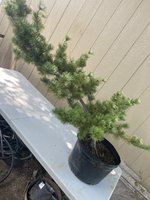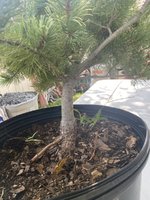Bakersbullion92
Sapling
Ok I’ll admit, I’m overwhelmed and scared. Lots of potential but way to inexperienced to execute. I’ve been watching this for awhile and today I bought it. Now I have not a clue on what to do  Help!!! I’ve done hours of research on this cultivar.
Help!!! I’ve done hours of research on this cultivar.
Japanese white pine approximate 10 years old…
What are the possible styles for this tree?
How would one go about actually bending and manipulating such a thick trunk line?
Should I clean up crotch growth?
Should I eliminate the whirling? If so how many is it ok to remove?
Do I use cut paste?
How do I deal with sap?
Should I trim candles?
I have so many questions.
I’m honestly lost with this one. It’s absolutely beautiful and don’t want to screw up such a nice tree with endless potential.
It’s about 5 ft long and trunk at base is almost 2 inches.
Thank you in advance!!!
Japanese white pine approximate 10 years old…
What are the possible styles for this tree?
How would one go about actually bending and manipulating such a thick trunk line?
Should I clean up crotch growth?
Should I eliminate the whirling? If so how many is it ok to remove?
Do I use cut paste?
How do I deal with sap?
Should I trim candles?
I have so many questions.
I’m honestly lost with this one. It’s absolutely beautiful and don’t want to screw up such a nice tree with endless potential.
It’s about 5 ft long and trunk at base is almost 2 inches.
Thank you in advance!!!
Attachments
-
 CA480399-E5CC-4370-97A2-5C09FAD1A3B8.jpeg252.2 KB · Views: 123
CA480399-E5CC-4370-97A2-5C09FAD1A3B8.jpeg252.2 KB · Views: 123 -
 EB27202B-D94D-4F8C-B9CD-6A5191B0C5D6.jpeg271.8 KB · Views: 108
EB27202B-D94D-4F8C-B9CD-6A5191B0C5D6.jpeg271.8 KB · Views: 108 -
 F9E354B4-7BF6-446F-8001-78CA1055509A.jpeg295.2 KB · Views: 92
F9E354B4-7BF6-446F-8001-78CA1055509A.jpeg295.2 KB · Views: 92 -
 67F51CCB-4032-4109-8E3A-192B4EAEBECD.jpeg261.4 KB · Views: 84
67F51CCB-4032-4109-8E3A-192B4EAEBECD.jpeg261.4 KB · Views: 84 -
 A865C65A-E4A8-4F44-AF5E-29683224925A.jpeg314.2 KB · Views: 82
A865C65A-E4A8-4F44-AF5E-29683224925A.jpeg314.2 KB · Views: 82 -
 4D917CB2-5DF7-4E4A-B230-837D7E047BF7.jpeg298.6 KB · Views: 74
4D917CB2-5DF7-4E4A-B230-837D7E047BF7.jpeg298.6 KB · Views: 74 -
 DF7AE31C-E5BB-45B6-9E32-A9216035A59F.jpeg293.9 KB · Views: 71
DF7AE31C-E5BB-45B6-9E32-A9216035A59F.jpeg293.9 KB · Views: 71 -
 DC7B0B07-715C-43C4-9D97-39A54F3A2018.jpeg334.3 KB · Views: 70
DC7B0B07-715C-43C4-9D97-39A54F3A2018.jpeg334.3 KB · Views: 70 -
 80D69C06-C62E-497A-A921-964E8F608383.jpeg258.3 KB · Views: 66
80D69C06-C62E-497A-A921-964E8F608383.jpeg258.3 KB · Views: 66 -
 ED7961A7-BBE6-4A3A-8693-6D3BD88A146C.jpeg267 KB · Views: 71
ED7961A7-BBE6-4A3A-8693-6D3BD88A146C.jpeg267 KB · Views: 71 -
 CF8446F5-C274-4335-A7DA-FE0595A12648.jpeg344.1 KB · Views: 59
CF8446F5-C274-4335-A7DA-FE0595A12648.jpeg344.1 KB · Views: 59 -
 96FDA459-7039-414D-A2F0-7BA8D5BFBA8C.jpeg322.4 KB · Views: 44
96FDA459-7039-414D-A2F0-7BA8D5BFBA8C.jpeg322.4 KB · Views: 44 -
 8EED3831-9D6A-4EB2-BAA7-C4AAEBC8F1AF.jpeg297.9 KB · Views: 45
8EED3831-9D6A-4EB2-BAA7-C4AAEBC8F1AF.jpeg297.9 KB · Views: 45 -
 54913E9B-B796-4825-89BE-F504183FD361.jpeg235.5 KB · Views: 58
54913E9B-B796-4825-89BE-F504183FD361.jpeg235.5 KB · Views: 58











